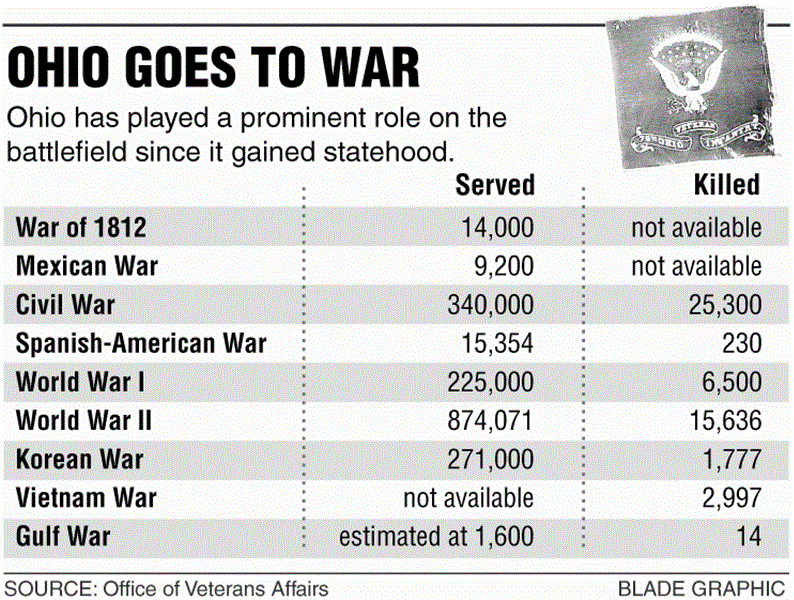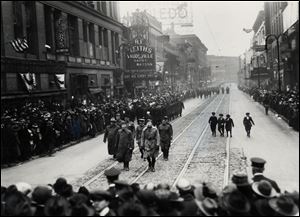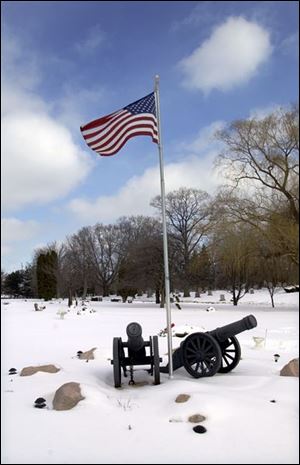
Thousands did duty when called to arms
3/2/2003

Returning troops parade down St. Clair Street from Adams Street toward Madison Street in Toledo on April 10, 1919.
They were soldiers, sailors, marines, and aviators who bore witness to the horrors of Antietam, Auschwitz, and Hiroshima and to the victories on Lake Erie and at Appomattox and Berlin.
Over the 200 years of Ohio's life, its status as one of this country's most populous states has produced armies of men and mountains of materiel for the making of war and the securing of peace.
From the frontier militiaman who handled an axe as well as a musket, to the engineers who helped fashion the atomic bomb, Ohio has answered the nation's calls to arms.
“Ohio has always had a reputation as being fairly supportive of the national government,” said Robert F. Smith, a professor of history at the University of Toledo whose specialty is military history.
That reverence for the government perhaps was a byproduct of the state's birth. Its lands were cleared of hostile Native Americans by the federal government and then defended vigorously prior to statehood in 1803.
Over the next two centuries, the state, with as many as 9 percent of the nation's people, offered them to service in vast numbers — often exceeding what could be expected.
For instance, during the Civil War, when Ohio was the third most populous state, it was home to roughly one in every 13 U.S. residents. Yet it produced nearly one-eighth of the men for the Union army and navy. With those vast numbers came vast sacrifice: more than 25,000 Ohioans died in the Civil War.
A generation later, during the Spanish-American War, Ohioans answered the call again when native son President William McKinley asked for 200,000 men. Ohio produced 15,000.
But more than just men, the state has produced battlefield leaders and heroes. William Henry Harrison, Ulysses S. Grant, William Sherman, James McPherson, and Philip Sheridan all wore the nation's uniform for Ohio. And Eddie Rickenbacker soared over the skies of Europe in World War I to international acclaim, becoming the United States' “ace of aces” by shooting down 26 enemy aircraft.
The state's initial role in the country's military history is locally bloody and nationally profound.
After the Revolutionary War, the young country attempted to enforce the Treaty of Paris, which called for the British to leave the territory west of the Allegheny Mountains and retreat into what is now Canada.
But aided by angry Native American tribes upset at the loss of their lands, the British remained until almost the end of the 18th century. It wasn't until the Battle of Fallen Timbers near Maumee, in 1794, that the tribes were defeated and the British retired north, opening the northwest to exponential growth.
Ohio hosted more bloodshed as the War of 1812 began. The state quickly responded to the call for men — three regiments were promptly raised for the impending fight.

The war, however, started poorly. A force led by Brig. Gen. William Hull left Urbana, Ohio, to pressure British troops at Detroit. After slogging through the Great Black Swamp of northwest Ohio, the command wilted at Detroit, and Hull surrendered to the British on Aug. 16, 1812, an act that led to a court-martial for Hull and a death sentence (later commuted).
It was then up to Major Gen. Harrison, commander of the U.S. Army of the Northwest, to stop the British from moving into Ohio. In early 1813 he camped on the Maumee River and ordered the construction of a fort.
After enduring two siege attempts, Fort Meigs — in present-day Perrysburg — still stood that summer, as had Fort Stephenson along the Sandusky River to the east. That forced Harrison's adversary, British Col. Henry Proctor, to retreat to Fort Malden in what is now Ontario, just south of Windsor.
In September, Commodore Oliver Perry took a hastily built U.S. Navy and eliminated the British fleet on Lake Erie near Put-in-Bay. Two months later, Harrison chased Proctor and his troops into Ontario, where he routed them.

Military graves and artifacts honor veterans at historic Woodlawn Cemetery.
Nearly half a century later, Ohio voted in 1860 for Abraham Lincoln, the president who would lead the Union into the Civil War.
Almost a third of a million Buckeye men served during the war, and they fought from Bull Run to Red River to Richmond. Many were like the Ohio 149th Regiment, asked to take on odds that appeared overwhelming. The unit, at the little-mentioned Battle of Monocacy River, was ordered to hold a position northwest of Washington on July 9, 1864.
For 12 hours they fought, losing ground, adjusting their lines, losing more ground. In the end they lost. Yet their tenacity slowed the Confederate advance on Washington, allowing for its defense.
“I feel justly proud of the manner in which the men conducted themselves during this first engagement,” wrote Col. Allison L. Brown in his report to his superiors. “They exhibited a coolness and determination which gives promise of great usefulness in the service of the country.”
During the two World Wars, Ohio would contribute a million men and women to the military. The state's 37th Division joined Gen. John Pershing in France during World War I, and it helped the Allies retake Verdun from the Germans. As the 37th fought on the ground, Captain Rickenbacker fought in the sky.
More than a generation later, Ohio was asked again to serve as World War II broke out. A total of 874,000 were sent off, more than 12 percent of the population. They were at Pearl Harbor and Anzio and Normandy. All told, more than 15,000 Ohio troops died in the war.
Some were with the armies that liberated the concentration camps, including John Searle of Perrysburg.
He was a sergeant in April, 1945, when his unit approached Ordrhuf, a Nazi labor camp. He saw the bodies scattered, lying where the retreating Nazis had shot them. “They were clothed, skinny,” Mr. Searle recalled years later. “It just looked like to me they worked them to death.”
As World War II evolved into the Cold War and then the “hot” wars of Korea and Vietnam, Ohioans again found themselves on the front and in the skies. In Korea, 271,000 men and women would participate, with more than 1,700 dying.
The number of Ohioans who served in Vietnam and the Gulf War is unavailable. An estimated 2,997 died in Vietnam, while 14 died during the Gulf War.
Today, with the country girding for a second battle with Iraq, Ohio National Guard and other military reserve units across the state have been mobilized, and others are anticipating a call. If a war breaks out, Ohio will be there. Again.